Ask Joshua: How Can I Brighten a Room That Gets Little Natural Light in Winter?
Hi Joshua,
My husband and I have lived in our home for about five years, and every winter we struggle to make our main living area feel bright and inviting. The weather can be pretty brutal here in the Boston area, and the lack of natural light makes the room feel dark and gloomy. What can I do to make it as bright as possible during the winter months?
– Amber, Boston, Massachusetts
A bright and welcoming mid-century modern beach house living room designed by virtual interior designer Joshua Jones of JJones Design Co. The layered textures, light walls, and sleek furniture show how to create a naturally bright space that feels cozy and refined even in winter.
Hi Amber,
That’s such a great question — and one I hear a lot from clients who live in areas with long, gray winters. When natural light is limited, the goal isn’t to fight it, but to layer warmth and reflection in ways that make the space feel naturally bright and balanced all day long.
Let’s start with your foundation. If your walls are on the darker side or painted in cool tones, consider switching to a light, warm neutral instead. Shades with soft beige, creamy white, or pale greige undertones will reflect more light without feeling cold or sterile. A hint of warmth in the color helps soften the winter gloom, especially when you’re dealing with cloudy days.
If you prefer wallpaper, you don’t need to skip it — just be mindful of the tone and pattern. Opt for light-colored wallpapers with subtle textures or organic patterns that create visual depth without overpowering the space. Grasscloth, linen-textured, or softly patterned papers can add warmth and interest while still keeping the room bright. Avoid dark, heavily saturated wallpapers in low-light spaces, since they tend to absorb what little natural light you have.
Next, focus on layering your lighting rather than depending on one bright overhead fixture. Combine a mix of floor lamps, sconces, and table lamps placed at different heights to create an even, cozy glow. Warm white bulbs — around 2700K — mimic natural daylight better than cool ones and instantly make the space feel inviting.
Another trick I often use is incorporating reflective materials. A well-placed mirror across from a window or lamp can bounce light around beautifully — especially if it’s a larger floor mirror, which reflects more of the room and captures changing light throughout the day. Just avoid the 1970s-style mirrored walls that were once built into entire rooms; they tend to make a home feel dated and drab rather than bright and airy. You can achieve a much fresher look with one statement mirror or a small grouping of framed ones.
When it comes to texture, think of soft and light-colored layers. Linen, boucle, or wool in neutral tones add warmth and visual interest without feeling heavy. Mixing different textures in a similar color palette keeps the room feeling airy and cohesive.
Lastly, take a look at your window treatments. Thick drapes or dark fabrics can unintentionally block what little daylight you have. Try light-filtering linen curtains or woven shades that soften the light without cutting it off completely. Even on cloudy days, the glow that comes through can make a big difference.
Small adjustments like these can dramatically change how a space feels in winter. It’s all about balancing light, warmth, and texture so your living area feels comfortable and inviting — no matter how gray it gets outside.
Thanks for the wonderful question, Amber. I hope these ideas help you bring a little extra light into your Boston home this winter.
Warmly,
Joshua
Have interior design related questions? You can ask Joshua here.



